During the past several years, we have spent a great deal of time focusing on the problem of excessive debt. From a structural perspective, the US economy will remain fundamentally weak until the debt issue is addressed in a meaningful way.
In his latest Outside the Box letter, John Mauldin forwarded an excellent paper written by Daniel Stelter of the Boston Consulting Group that examines the magnitude of the challenge facing the developed economies of the world. We have reprinted an excerpt from the paper below and recommend reading the commentary in its entirety.
“Over a protracted period of good times, capitalist economies tend to move from a financial structure dominated by hedge finance units to a structure in which there is a large weight to units engaged in speculative and Ponzi finance. . . . The greater the weight of speculative and Ponzi finance, the smaller the overall margins of safety in the economy and the greater the fragility of the financial structure.” —Hyman Minsky, 1992
In 1920, an Italian immigrant to the U.S. by the name of Charles Ponzi created the scheme that would cause his name to live on in history. He announced an arbitrage business that would buy postal reply coupons in Italy and exchange them for stamps in the U.S., taking advantage of significant price differences due to high postwar inflation. He attracted investors by promising extraordinarily high returns—50 percent within 45 days. But instead of investing the money to buy the coupons and exchange them for stamps, he simply used the money of later investors to pay high returns to earlier investors, extracting huge profits along the way. By the time the fraud collapsed, investors had lost nearly $20 million, the equivalent of about $225 million in 2011 dollars. Such frauds have been known as Ponzi schemes ever since.
The second-biggest Ponzi scheme in recent history—organized by the New York hedge-fund manager Bernard Madoff—led to losses of approximately $20 billion in 2008. The biggest, however, is still ongoing: the Ponzi scheme of the developed economies. It is not simply that the developed world has borrowed significantly from future wealth to fund today’s consumption, leading to huge burdens for the next generation. It has also reduced the potential for future economic growth, making it more difficult for the next generation to deal with this legacy.
It may seem harsh or exaggerated to liken the current troubles of the developed economies to a Ponzi scheme. I do so deliberately to emphasize the scope and seriousness of the problem. Nearly five years after the financial crisis, the leaders of the developed world are far too complacent. Politicians and central bankers have continued to “kick the can down the road,” pursuing policies designed to postpone the day of reckoning and avoid telling the public the truth: that a sizable part of the debt will not be paid back in an orderly way.
Fortunately, there is still time to act. But leaders from all social sectors—government, business, organized labor, environmental and other stakeholder groups—need to act decisively and quickly in order to secure future economic prosperity, social cohesion, and political stability. It is in the nature of Ponzi schemes to collapse suddenly, without warning. No one knows what event may send the developed world and the global economy as a whole back into crisis.
This paper explores the causes and characteristics of the developed world’s Ponzi scheme and proposes ten steps that every developed economy will have to take to resolve it. All stakeholders will have to make sacrifices. Creditors will have to accept losses. The wealthy will have to pay more taxes. Wage earners will have to work longer and save more for their retirement. Public spending on social welfare will have to be cut, even as spending in new areas of social investment will have to be increased. Government will have to get smaller and more efficient. And because these problems don’t affect the developed economies alone but also global growth, the emerging economies will have to contribute to the solution by consuming more and exporting less.
Who pays and who benefits will be subjects of intense political controversy. How critical tradeoffs are managed will vary from country to country. But rather than address these issues, this publication simply aims to highlight the painful dilemmas that the developed world faces, to define the necessary steps toward a genuine solution, and to create a sense of urgency for rapid action.
The Origins of the Ponzi Scheme
The developed world’s Ponzi scheme is caused by record-high levels of public and private debt. And it is exacerbated by huge unfunded liabilities that will be impossible to pay off owing to long-term changes in developed-world demographics.
Since the Second World War, debt levels in the developed economies have continually risen, with a notable increase since 1980. According to a study by the Bank for International Settlements (BIS), the combined debt of governments, private households, and nonfinancial companies in the 18 core countries of the OECD rose from 160 percent of GDP in 1980 to 321 percent in 2010. In real terms, after inflation is taken into account, governments have more than four times, private households more than six times, and nonfinancial companies more than three times the debt they had in 1980.
There is, of course, nothing wrong with taking on debt, as long as that debt is invested to create additional economic growth. In recent decades, however, the vast majority of debt has not been used to increase future income but to consume, to speculate in stocks and real estate, and to pay the interest on previous debt. One indication of this trend: during the 1960s, each additional dollar of new credit in the U.S. led to 59 cents in new GDP; by the first decade of the new century, that same dollar of credit was producing just 18 cents in new GDP.
These rapidly rising debt-to-GDP levels are a sign of the growing share of what the late economist Hyman Minsky termed “Ponzi financing” in the global economy. Minsky distinguished three types of credit-based financing, determined by the financial strength of the debtor:
- Hedge financing, in which the debtor has sufficient cash flow to pay interest and to pay back the principal.
- Speculative financing, in which the debtor can service the loan—that is, he or she can pay the loan interest that is due but not repay the principal out of income cash flows. Therefore, the debtor needs to continuously roll over liabilities by contracting new debt in order to meet the obligations on maturing debt.
- Ponzi financing, in which the debtor doesn’t have enough cash flow to cover either the principal or the interest. While hoping that the asset will rise faster in value than the total financing cost, he or she must borrow even more to meet the interest payments. The ultimate goal is to be “bailed out” by selling the asset to the next buyer.
Today the developed world looks for a “next buyer” to take over its excessive debt load. Unfortunately, there is no such buyer in sight. The Ponzi scheme will have to be unwound.
How much money are we talking about? The amounts are extraordinary. The threshold for sustainable government debt is a debt-to-GDP ratio of roughly 60 percent. Applying that threshold to nonfinancial corporate debt and private-household debt as well gives an overall “sustainable debt-to-GDP ratio” of 180 percent. Currently, the amount of debt above that level is approximately $11 trillion for the U.S. and €7.4 trillion for the Eurozone.
Although it is nearly five years since the onset of the financial crisis, we are still just beginning to unwind these massive sums. So far, only Italy, Japan, and the U.S. have started to deleverage. (See Exhibit 1.) In the case of the U.S., this deleveraging of the private sector is mainly the result of defaults, not of actually paying back loans. Other highly indebted economies such as the U.K., Spain, and France are still piling up additional debt.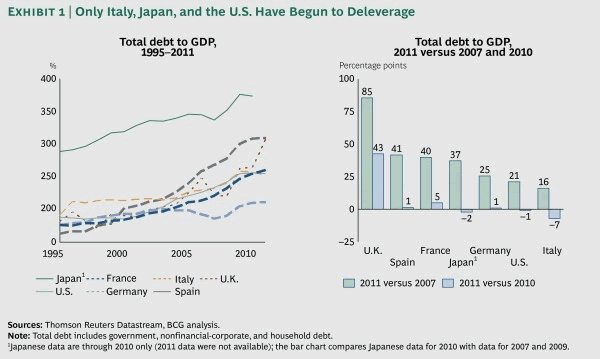
As bad as the excessive debt burden is, however, it is only part of the problem. The developed world’s Ponzi scheme is greatly exacerbated by the hidden liabilities of governments and companies, especially when it comes to age- or health-care-related spending.
The basic approach to paying for such costs has not changed much since the invention of social insurance by Germany’s Chancellor Bismarck in 1889: the younger generation pays for the older generation. Bismarck lived until 83, but such longevity was the exception at the time. The average life expectancy then was 37 years for men and 40 years for women, while insurance was paid only from the age of 70 onwards. Thus, relatively few workers could expect to enjoy payments from public insurance.
Over the past century, however, life expectancy has doubled and fertility rates have declined by more than half in the developed world. In 1880, the median fertility rate among women in today’s G-7 countries of Canada, France, Germany, Italy, Japan, the U.K., and the U.S. was 4.6; today, it is at or below the rate of natural reproduction of 2.1, with rates in Germany, Italy, and Japan as low as 1.4.
At the same time, the retirement age has been lowered significantly—so much so that the number of retirees supported by the working population has grown precipitously. In Germany, the old-age dependency ratio (that is, the number of persons age 65 or above per 100 persons of working age) was 14 percent in 1950; it is 31 percent today. And it will increase to 57 percent by 2050. In other words, every retiree will need to be supported by fewer than two fully employed people. In Japan, the dependency ratio was only 8 percent in 1950; it is 35 percent today and will climb to 70 percent by 2050. By the end of this century, there will be at least a 50 percent dependency ratio in most developed countries.
The financial implications of this growing welfare burden are dramatic. According to another BIS study, even in a benign scenario in which current deficits were reduced to precrisis levels and age-related spending was frozen at current levels of GDP, public debt would continue growing at a significant rate. Only Germany and Italy would be able to stabilize their debt levels in such a scenario. (See Exhibit 2.) Nor are states and local governments immune. In the U.S., for example, one estimate puts the unfunded liabilities for city and state employees in the neighborhood of $3 trillion to $4 trillion.
Private companies that provide fixed-benefit pensions are also confronting significant underfunding of their pension promises. In 2011, the S&P 500 companies had combined unfunded liabilities of more than $500 billion; liabilities of the European Stoxx 600 were more than €300 billion. For some companies, unfunded liabilities are equivalent to more than 50 percent of their market capitalization. In the current environment, it is highly unlikely that larger investment returns will automatically solve the problem. Such companies will have to fund the gap out of current cash flow, cut their liabilities by offering diminished lump-sum buyouts (as GM and Ford have recently done)—or partially renege on their promises, as the public sector will inevitably do.
Meanwhile, private households have relied too long on rising home-asset prices and the promises of politicians and corporate managers instead of putting aside dedicated funds for retirement. In some countries, private households need to deleverage precisely at a time when they should be building up assets for the future. What’s more, the aggressive monetary policies of the leading central banks, designed to stimulate economic growth, have had the perverse side effect of reducing interest income and expected future returns as asset values become inflated, forcing households to increase their savings even more.
A Broken Growth Formula
Addressing these challenges at any time would be difficult. To make matters even worse, however, they come at a moment when the developed world’s traditional model of economic growth appears to be broken. This is partly a consequence of the Ponzi scheme itself. Economic growth is negatively affected by high levels of debt. In this respect, the tendency of the developed economies to fund today’s living with future income has not only created the global Ponzi scheme—it has also severely undermined the ability to resolve it. But the broken growth model is also due to long-term demographic trends and other changes.
Economists Carmen Reinhart and Kenneth Rogoff have demonstrated that as soon as government debt crosses the threshold of roughly 90 percent of GDP, it begins to have a negative impact on an economy’s growth rate. In addition, the BIS has shown that the impact is similar for nonfinancial corporate debt and household debt, and that at least two of these three sectors have crossed the 90 percent threshold in most of the developed economies. (See Collateral Damage: What Next? Where Next?—What to Expect and How to Prepare, BCG Focus, January 2012.)
The government’s share in the economy, measured by government spending as a share of GDP, has a negative impact on economic growth as well. A recent study found that an increase in government size of 10 percentage points is associated with a lower growth rate of between 0.5 percent and 1 percent. In most European countries, government spending is currently about 40 percent of GDP or more, and in some countries, such as France and Denmark, it accounts for nearly 60 percent. (See Exhibit 3.) Even in the U.S., government spending’s share of GDP is 40 percent. By contrast, the share of government spending in developing countries is between 20 and 40 percent. Oversized public sectors create an additional drag on future growth, amplifying the impact of too much debt.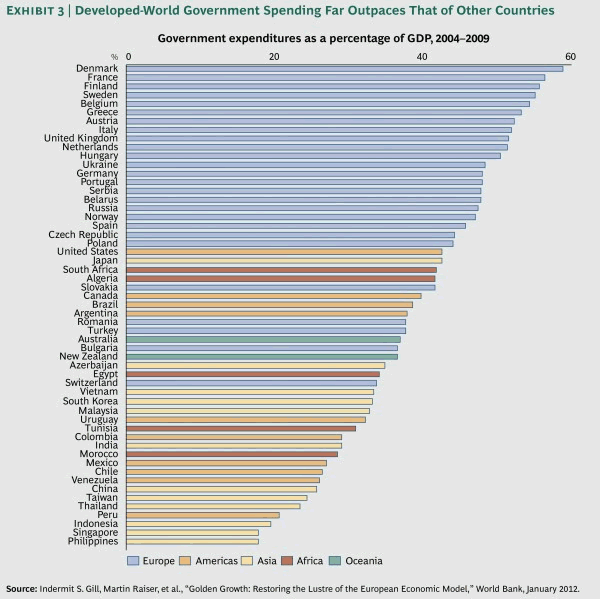
A critical problem in the decades to come will be labor scarcity. This may seem strange given that many advanced economies are currently suffering from high unemployment. But according to projections by the United Nations, between 2012 and 2050, the working-age population between the ages of 15 and 64 in Western Europe will shrink by about 13 percent (to 15.8 million people). In Japan, it will drop by 30 percent (to 23.8 million people). The U.S. working-age population will grow slightly, at 0.4 percent per year, but that is slower than the annual growth rate of 1.1 percent over the past 20 years. The fewer people in the workforce, the less GDP generated and, therefore, the less income available to pay down existing debt.
This trend is not limited to the developed world. China and Russia will also see their workforce shrink by 2020. Meanwhile, the workforce in India, the rest of Asia, Latin America, and Africa will grow at least until 2040 and perhaps even beyond. (See Exhibit 4.)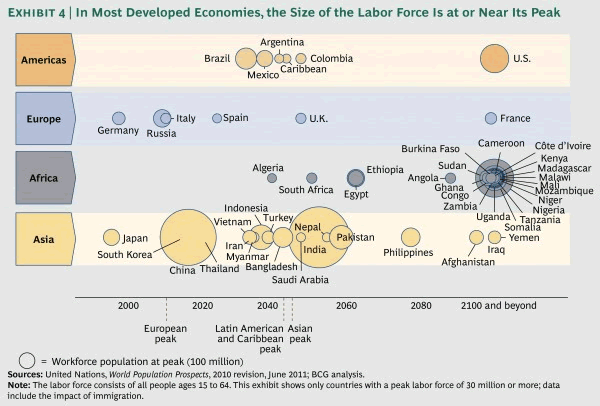
Just as important as the number of available people in an economy’s workforce is the productivity of that workforce. Consistent increases in productivity have made possible the economic transformation of the developed world over the past 200 years and of emerging markets today. There are signs, however, that the rate of improvement in productivity is in decline. In a provocative paper, the renowned growth researcher Robert Gordon, of Northwestern University, makes a compelling case that growth in GDP per capita has been slowing since the middle of the twentieth century. He argues that “the rapid progress made over the last 250 years could well turn out to be a unique episode in human history.”
Of the factors Gordon cites for this phenomenon, the most important is diminishing returns from innovation. In the 1920s, the Russian economist Nikolai Kondratiev identified a pattern of economic growth consisting of successive “long waves” of economic development, in which periods of rapid growth were interspersed with periods of slower growth and financial crisis before a new cycle of growth began. Later, the Austrian economist Joseph Schumpeter showed how these long waves were associated with major advances in basic innovation—for example, the steam engine, electricity, and the automobile.
According to Gordon, the problem today is not merely that the incremental productivity impact of the most recent wave of innovation, associated with information technology and communications, has diminished in recent decades. Rather, he argues that the space for truly fundamental innovations that result in step-change improvements in living standards is getting smaller and smaller. As he puts it, the invention of indoor plumbing was orders of magnitude more important than the invention of the iPad, Twitter, and Facebook. (See Exhibit 5.)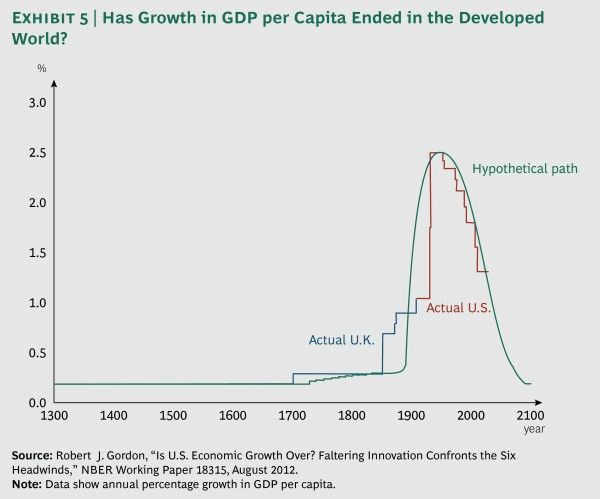
Of course, Gordon’s view may underestimate the creative power of entrepreneurship to identify and bring to market productivity-enhancing innovations, as The Economist has recently argued. Nevertheless, his view needs to be taken seriously. Innovation may continue to have a positive impact on GDP and living standards, but the marginal effect may very well be less significant in the future than it was in the past.
The deteriorating quality of education in most advanced countries also undermines future growth potential. Today, China produces more scientists every year than the U.S.—approximately 310,000 in 2010 compared with 255,000 in the U.S.—and about ten times the number of engineers (2.2 million). And the number of educated people is just one side of the coin. Asian countries regularly surpass developed nations in educational results. In 2009, when Chinese students (from Shanghai) were included for the first time in the OECD’s triannual PISA (Programme for International Student Assessment) tests, they immediately ranked first.
Increasing differences in education within the countries of the developed world are an additional burden. In the U.S., the “achievement gap”—the performance difference between African Americans and Hispanics, on the one hand, and white and Asian Americans, on the other—has widened, leading to overall poorer results as the first two groups’ share of the population grows. The same holds true for most countries in Europe, where the descendants of immigrants from Turkey, Africa, and the Arab world tend to perform less well than nonimmigrants or the descendants of immigrants from other regions. Unless these performance differences are addressed, it will be increasingly difficult for members of the next generation to compete with the rest of the world and with each other—let alone pay for the retirement of the current generation of baby boomers.
Any global traveler will have experienced how much progress the developing world has made in its investment in public and private infrastructure. At the same time, the public and private sectors in the developed world have underinvested in capital stock. This will have a negative impact as well, because capital investment is a key determinant of future productivity and income generation.
Despite record-high profit margins, businesses in the developed economies have significantly reduced their investment in new machinery and equipment. A recent Goldman Sachs report argues that Europe has witnessed a decade of underinvestment, starting before the financial crisis and intensifying since then. The average asset age increased to 10.3 years in 2011 from 7.4 years a decade before, representing an investment backlog of some €800 billion. The same trend holds true for U.S. companies. Nonfinancial corporate businesses in the U.S. show significantly higher savings levels compared with investments in almost every year since 2000; there is also a clear downward trend in net domestic fixed investments relative to GDP. (See Exhibit 6.)
Ever since the 1972 publication of The Limits to Growth by the Club of Rome, there has been an ongoing debate about how long the easy (and relatively economical) availability of the world’s natural resources will last. Some observers are confident that long-term declines in the price of raw materials (real prices have fallen by half since the 1860s) will continue, citing the fact that new raw-material deposits have been regularly found or substitutes identified. Others, however, argue that the period of declining prices has come to an end.
On balance, it makes sense to assume structurally higher raw-material prices, notwithstanding constant and high volatility in the economic cycle. The speed of economic development in the emerging markets and the sheer number of people aspiring to a developed-world lifestyle support this view. Efforts to reduce energy consumption and carbon-dioxide emissions in order to protect the environment will lead to higher costs as well. And if the scenarios predicted by researchers are correct, the costs of dealing with the implications of climate change will only increase in the coming decades.
In conclusion, the availability of cheap natural resources, which for more than a century has been an enabler of productivity improvement, may be ending. Higher costs will lead to more global disputes over resources and fewer financial resources to pay down debt.
Globalization has brought the promise of economic prosperity to billions of people around the world. But it has also contributed to tougher international competition and the creation of new inequalities of wealth and income in the developed world. The growth in the global labor force continues to put pressure on labor costs in developed economies. At the same time, globalization is leading to increasing inequalities in income and wealth within countries, as some groups (such as investors) benefit more from increased globalization than others (such as manufacturing workers).
Income statistics highlight this development: between 1979 and 2007, the income of the average U.S. household grew by 62 percent. Over the same period, the income of the top 1 percent of households grew by an extraordinary 275 percent and the income of the rest of the top 20 percent grew by a slightly above-average 65 percent, while the income of the remaining U.S. households grew by less than 40 percent. The incomes of the lowest quintile grew by only 18 percent.
Inequality increases the risk of social unrest and declining support for capitalism and a free society. As University of Chicago economist and former IMF chief economist Raghuram Rajan points out, “Ultimately, a capitalist system that does not enjoy popular support loses any vestige of either democracy or free enterprise.”
No one knows how long the developed world’s Ponzi scheme can go on without causing major social and economic breakdowns. As long as it does, however, economic uncertainty will remain high. One indicator of growing uncertainty is an index developed by economists Scott Baker and Nicholas Bloom, of Stanford University, and Steven Davis, of the University of Chicago. (See Exhibit 7.) Their “economic policy uncertainty index” shows not only that overall levels of uncertainty have risen since the financial crisis, but also that this uncertainty is increasingly driven by political disputes over economic issues rather than by events such as 9/11, for example, or military conflicts such as the First Gulf War. To the degree that politicians and other leaders fail to address the structural challenges described in this paper, the odds of economic paralysis go up.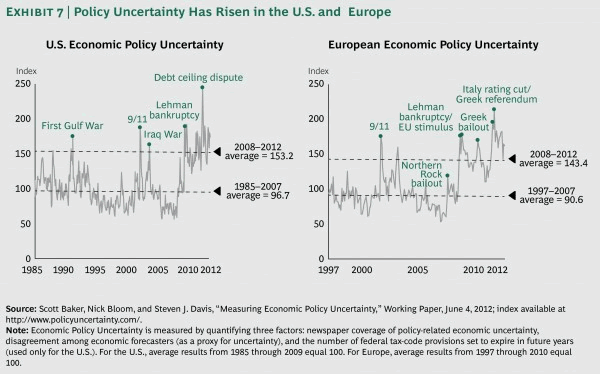
The underlying issues cannot be ignored any longer. The developed world faces a day of reckoning. It is time to act.
